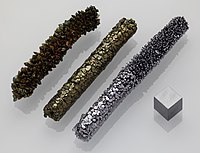
Photo from wikipedia
Abstract In this work, we report the time-dependent morphological evolution of the as-prepared vanadium dioxide (VO2) and its electrochemical performance for supercapacitor applications. VO2 with different morphologies (microspheres and nanosheets)… Click to show full abstract
Abstract In this work, we report the time-dependent morphological evolution of the as-prepared vanadium dioxide (VO2) and its electrochemical performance for supercapacitor applications. VO2 with different morphologies (microspheres and nanosheets) were successfully synthesised by solvothermal method for time growth ranging from 2 h 30min to 12 h at a temperature of 200 °C. X-ray diffraction (XRD), Raman spectroscopy, scanning electron microscope (SEM), high resolution transmission electron microscopy (HRTEM), energy dispersive spectroscopy (EDS), gas adsorption/desorption analysis and X-ray photoelectron spectroscopy (XPS) were used to characterize the structure, morphology, composition and the oxidation state of the as-prepared samples. The electrochemical behaviour of the as-prepared VO2 samples were analysed in a three-electrode cell configuration using 6 M KOH aqueous electrolyte. The VO2 samples revealed monoclinic crystal structure (with VO2 (B) monoclinic phase for the samples prepared for 4 h and 6 h and VO2 (A) monoclinic phase for the samples grown for 2 h 30min and 12 h). The VO2 samples grown for 4 h and 6 h displayed nanoflakes and nanosheets-like morphology, respectively, whereas VO2 samples grown for 2 h 30min and 12 h revealed nanorods-like morphology. The 6 h grown sample also showed more porous structure leading to much higher specific surface area, pore volume and enhanced electrochemical performance with highest specific discharge capacity of 49.28 mA h g−1 at current density of 0.5 A g−1 and the corresponding specific capacitance of 663 F g−1 at a scan rate of 5 mV s−1 with excellent cycling stability as compared to others samples. Accordingly, the 6 h is considered to be optimal growth time for VO2 nanosheets for considerable potential as an electrode material for supercapacitor applications.
Journal Title: Materials Chemistry and Physics
Year Published: 2018
Link to full text (if available)
Share on Social Media: Sign Up to like & get
recommendations!